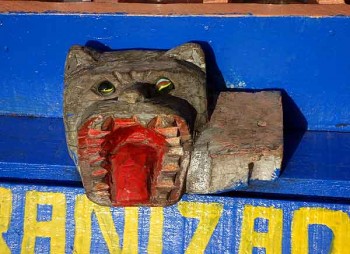
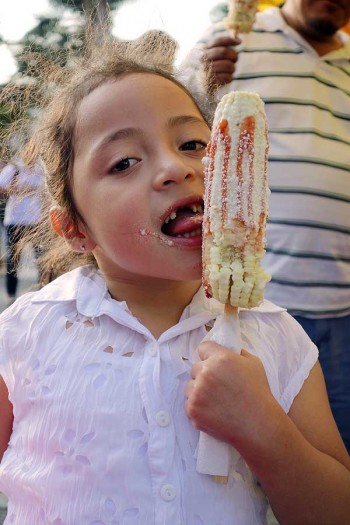
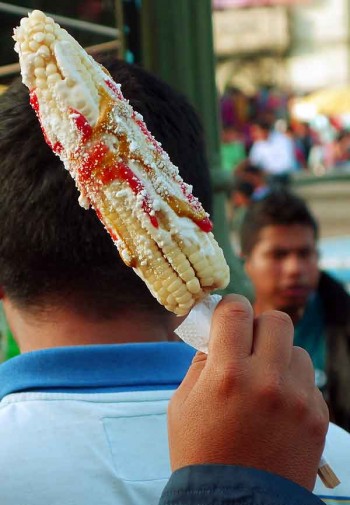
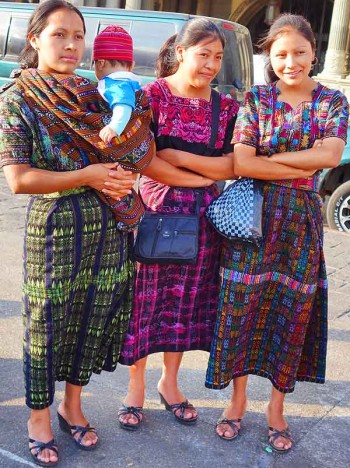
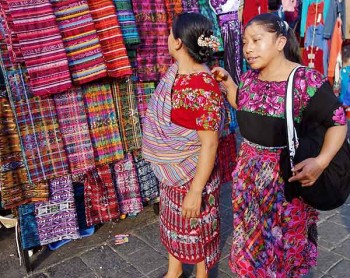
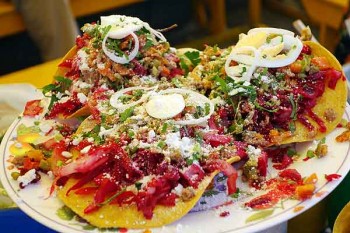
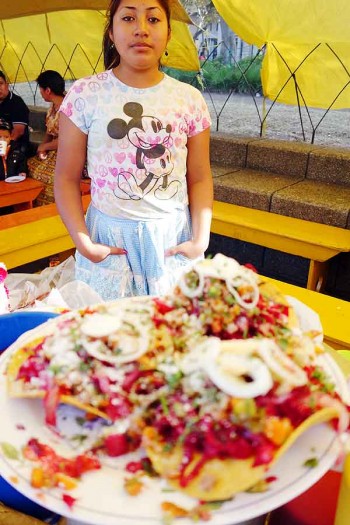
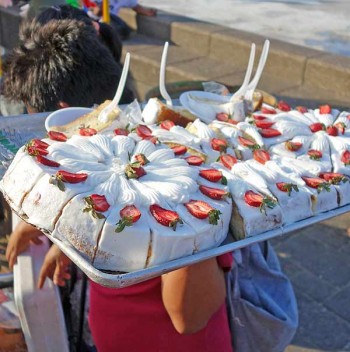
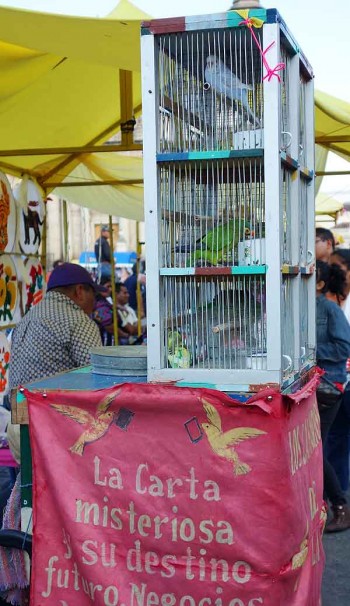
Parque Central
Before I speak about the horrendous street crime in Guatemala City, I’d like to dwell on the pleasant aspects of the city. We spent Sunday afternoon in Parque Central. It was teeming with people and not a gringo in sight. Lots and lots of children, and women everywhere breastfeeding babies without prudish concerns.
If I felt like a giant among little people, how must Bob have felt, at six feet five? The Mayan women, all under five feet tall, looked so elegant with their long, glossy, black hair and colorful dresses.
I was entranced by the gorgeous woven cotton that all the Mayan women wear. Not dresses, they are sarongs fastened with a belt over tucked-in matching blouses. I wanted to buy a length of the fabric but was shocked that the opening price at each stall I visited was US$150. This was not a credit card type of market and, since our mission was thiefhunting, I had very little cash. It’s just as well—I would have had an impossible time selecting just one of the colorful patterns.
Surrounding the fabric stalls, everything else was for sale, too: bootleg DVDs, heaps of clothes piled on spread-out blankets, hair-do contraptions, inflatable Spidermen, jewelry, toys, underwear, earphones, puppies, remotes, and, thankfully, wallets. Our prop wallet was stolen for good—a rare occurrence, as we almost always manage to get it back after a theft.
And what’s a market without food? Boys at wooden carts worked with giant machetes preparing coconuts to drink. There were mountains of peanuts, trays of white, spiral-peeled oranges, flabby chicken sputtering on charcoal grills, and festive corn-on-the-cob-with-complicated-condiments. The tostadas looked mouth-wateringly good; the fly-specked strawberry cake did not.
A boy sat behind four bathroom scales lined up on a cloth that marked his territory. A few coins were arrayed on the cloth, too. Why four scales? Was the boy often busy with simultaneous customers? Does a customer flip a coin to select one of the scales? Or take an average weight of the four?
Other questions arise for the men whose birds will select your destiny. Are the tiny printed fortunes marked? If you pay more, can you be sure the bird is given only good futures to choose from? Are there any bad ones?
Street Crime in Guatemala City
Parque Central is a quaint and charming sliver of Guatemala City, but violence lurks in its very shadows. I’ve already written of our own experience with pickpockets there; no potential visitor should be unaware of the serious warnings about the country’s crime scene. On February 1, 2014, about the time we visited, Wikitravel’s Guatemala Travel Guide said (among many warnings):
Guatemala has one of the highest rates of violent crime in the world. Guatemala experiences much violence; its citizens live in a world of violence and tourists will be no different. Use extreme caution if traveling to Guatemala. … If you are mugged, carjacked, or approached by armed individuals, cooperate. Do not make any sudden movements, and give whatever belongings or money that are demanded. Citizens and tourists have been shot and killed for resisting muggers. … Do not use buses at night in Guatemala City, as buses are frequently robbed by gangs.
The very long U.S. Department of State’s Guatemala 2013 Crime and Safety Report is more specific, more frightening, and great reading:
Theft, armed robbery, and carjacking are the most common problems encountered by American citizens. No area is immune to daytime assaults, including the upscale shopping, tourist, and residential areas of zones 10, 14, 15, and 16 in Guatemala City. There have been numerous reported incidents of bank patrons being robbed outside banks after withdrawing large sums of money, suggesting possible complicity of bank personnel on the inside. A particularly troubling trend is the use of motorcycles for armed robbery. Typically, two men on a motorcycle accost the driver of a car and demand the driver’s cell phone. Armed robberies to steal a cell phone have turned violent. In May 2009, a new law mandated that only the operator is allowed on the motorcycle.
The report goes on to describe highway robberies perpetrated by uniformed police or pseudo cops; the rising threat of robberies from occupied vehicles, including those stopped at traffic lights; armed security guards who exist “for decoration only;” violent bus bandits; and carjacking, even on main roads in broad daylight. The report also warns arriving visitors:
Minimize time spent standing outside in the airport passenger pick-up area, and do not walk out of the airport with valuables in plain sight. Carry laptops inconspicuously.
I shudder to think of my mistakes, though they were unavoidable. Our scheduled driver did not show up at the airport. We waited 40 minutes in total “outside in the airport passenger pick-up area.” We were not allowed back inside the airport to look for assistance or official transportation options. Therefore, in full view of many gawkers, I had to take out my laptop “conspicuously”—a massive 17” MacBookPro—to find the phone number of our Guatemala City contact. I should have had it available on paper. Instead, I was forced to flaunt my valuables.
Persons carrying laptop computers and expensive cell phones are often targets for armed robberies. Visitors should avoid using a laptop in a public place, such as a cafe…
…or airport pick-up zone. Had I only read this before my arrival! No, we weren’t robbed, but that might only be due to our very early morning arrival. We got into a hotel shuttle which, according to reports, is just as prone to armed attacks as anything:
Private vehicles, taxis, and shuttle buses have all been targeted. Typically, assailants steal money, passports, and luggage, and in some cases, the vehicle as well.
We were safely dropped at our hotel where, after a nap, we began our research of street crime in Guatemala City. Of course it would have been wiser to read up beforehand, but our hectic travel schedule doesn’t always permit such luxuries (reading about every destination before arrival).
Visitors should avoid using a laptop in a public place, such as a cafe or in wireless zones. Areas that offer wi-fi computer services have been targeted. Several individuals have been killed and their laptops taken upon departure from these establishments after they were seen using their computers in public.
Had our hotel not had decent internet access, it’s very likely that we’d have taken our laptops out to find wifi elsewhere. I can just imagine reading the quote above (from the U.S. Department of State on Guatemala), not to mention the rest of the warnings, most of which I have not mentioned, while sitting in a Guatemala City cafe with wifi. I’d be petrified to leave!
One of the first (horrific) statistic-riddled reports I read, “Guatemala: Violence perpetrated by criminal gangs…” published by the Immigration and Refugee Board of Canada, focused on violence by criminal gangs. 183 bus drivers were assassinated in 2010 for refusing to pay gangsters’ “protection fees,” and these numbers have continued. Ninety-some percent of crime goes unpunished (depending on whose figures you read). There are said to be 14,000 gang members in the country and most communities are affected.
No wonder the police are ineffective. Many are not even high school graduates, their training may be as short as six months, and they get a salary of under $600/month. Bribes are a way of life. Drug cartels have pretty much taken over the country.
We met two 50ish British women in our hotel lobby. They’d come to Guatemala City to learn Spanish, unaware of the crime scene. They learned quickly though, and by following the rules had no incidents. They carried nothing at all of value. No purses or handbags or cameras. They stayed together. They didn’t go out at night. They avoided the known danger zones. They only used taxis from the hotel; they did not flag cabs in the street.
Our visit to Guatemala City reminded me of the importance of research before travel, even if you only read a little. Because don’t we all read up on the weather, the restaurants, nightlife and attractions? Let’s not forget to seek out crime and safety reports, too. The U.S. Department of State maintains excellent, current reports.






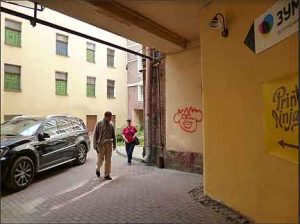
2 Comments
i come from guatemala and been in guatemala city and not once have we been stolen from and we visted from the u.s and in fact we lost a ipad , passports, and 2000 dollars in a taxi and it was returned to us that shaows that there isnt theives lurking around
How unaware we were when we visited there. We saw lots of little people, all smiling, and gorgeous fabrics.